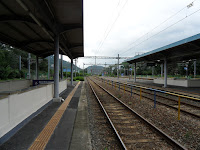A small town named Samnangjin 삼랑진 is around the confluence of two rivers, the Nakdong river 낙동강 and the Miryang river 밀양강. Samnangjin refers to a river dock where choppy water fed by three tributaries flows over the surface. Since Shilla dynasty(57~935 AD), a river dock located here had actually played a principal role in the water transportation route along the Nakdong river. It later became one of the biggest docks along the Nakdong river during Joseon Dynasty(1392~1910 AD) whose role was more emphasized as a collecting center for taxes, and it had a prosperous period in its history. The tax was usually paid in grain, cotton cloth, and coin. In 1765, a tax warehouse named Jochang 조창 was opened on the riverside at the confluence to store the taxes collected from 6 regions, including Miryang, Gimhae 김해, and Hyeonpung 현풍. Jochang refers to a warehouse for taxes arrived by ships. This route was linked to Samunjin 사문진 and Gangchang 강창 river docks.
A railway station was opened 3 km inland northeast of Jochang in 1905. Since overland traffic was introduced, the water transportation route had decayed. Jochang was closed, cherishing old memories, and the town center was newly moved to Songji 송지 nearby, where a railway station was built. However, Samnangjin had flourished again since the railway station became a junction, which is connected to Seoul 서울, Busan 부산, and Masan 마산.
During the Japanese colonial period, Samnangjin railway station had a big official residence for railway workers, which still remains partly renovated on the gentle slope to the north of the station. The residence is on a unique wall made of stone and cement that can be easily found in the typical Japanese castle architecture.
Meanwhile, since the first track had been partly relocated, the single-track bridge named Samnangjin bridge near Jochang was abandoned. Now it is still one-way car traffic or used by cyclists. It was nicknamed "Bridge on the River Kwai" in Thailand. Old rusty iron railway bridge is often called that in Korea.
During the Japanese colonial period, Samnangjin railway station had a big official residence for railway workers, which still remains partly renovated on the gentle slope to the north of the station. The residence is on a unique wall made of stone and cement that can be easily found in the typical Japanese castle architecture.
Meanwhile, since the first track had been partly relocated, the single-track bridge named Samnangjin bridge near Jochang was abandoned. Now it is still one-way car traffic or used by cyclists. It was nicknamed "Bridge on the River Kwai" in Thailand. Old rusty iron railway bridge is often called that in Korea.








